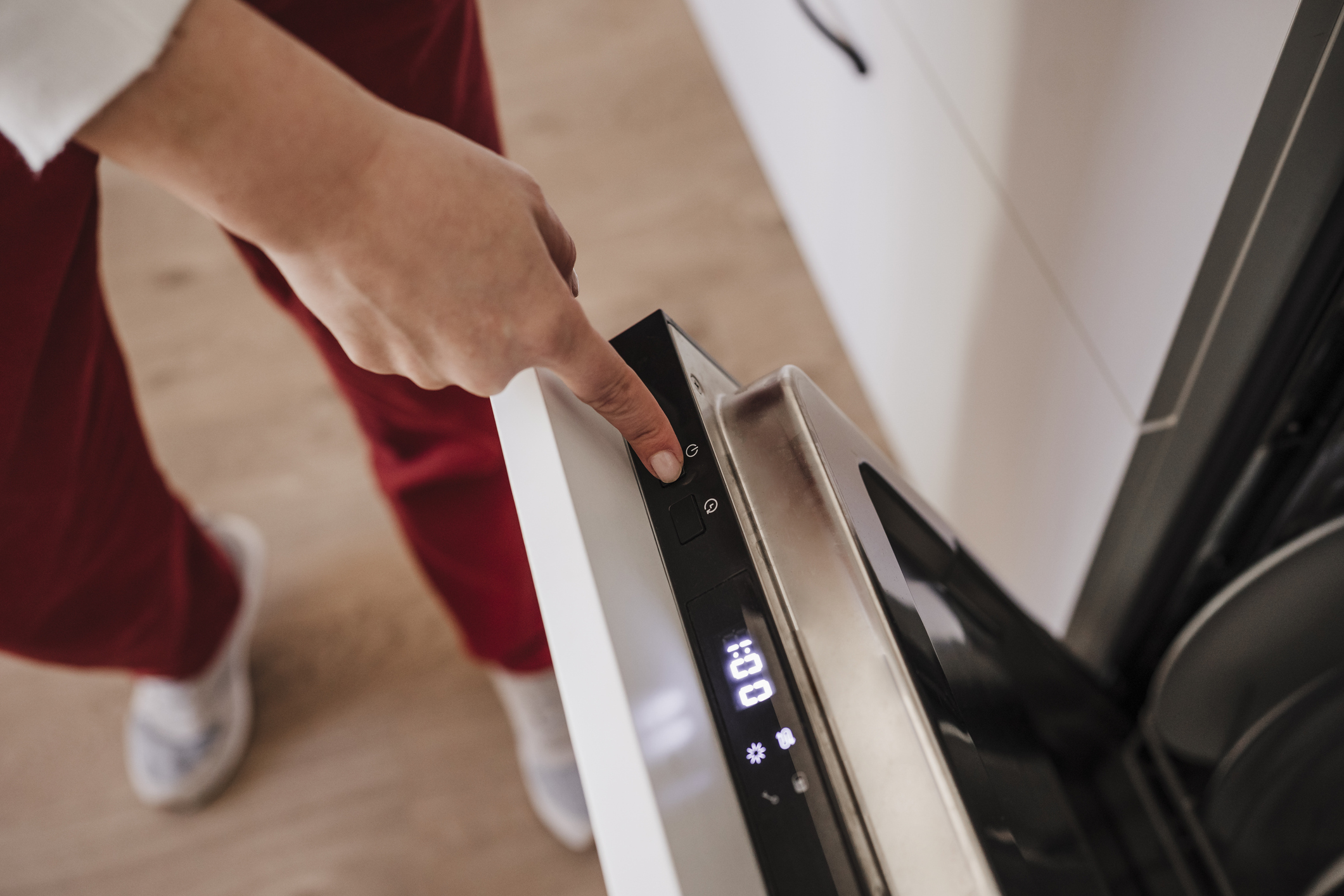We may earn revenue from the products available on this page and participate in affiliate programs. Learn More ›
As one of the core elements in a modern kitchen, dishwashers are something many homeowners take for granted. The first dishwasher appeared back in 1886 and was a wooden hand-powered contraption that washed dishes by spraying soapy hot water, then clean rinse water.
Today, more than 89 million households in the United States have a dishwasher, according to the U.S. Energy Information Administration (EIA). And many people wonder how they could manage their household without a dishwasher, since it saves time and labor and effectively cleans kitchen items in a hygienic way.
Despite their presence for generations, dishwashers have undergone extensive upgrades as new technologies and designs have been integrated into dishwasher models to meet today’s lifestyle needs. “Dishwasher innovation has focused on numerous advancements over the last 10 to 20 years and made the dishwasher more efficient, flexible, and quiet—giving home cooks more options to support their every need and supporting a growing desire for more sustainable usage,” says Mattia Sala, product manager at SMEG USA.
Here are some of the new conveniences you can now enjoy with a modern dishwasher as a result of innovations to dishwasher technology.

1. More Energy Efficiency
The most widely discussed shift in dishwashers over the past decade or so is how much more efficient they are now. “Over the past 20 years, there has been an increased focus on reducing the energy consumption and costs associated with running large appliances like dishwashers,” notes Sala. Energy Star-certified dishwashers are more prevalent, and they use 12 percent less energy and 30 percent less water than standard models, on average, which saves more than 8,000 gallons of water each year.
According to the U.S. Department of Energy, these certified models from a variety of manufacturers contain “several innovations like soil sensors, improved water filtration, more efficient jets, and dish rack designs that reduce energy and water consumption and improve performance.”
Through the use of turbidity sensors, more efficient pumps, spray arms, and drying technologies, current Miele dishwashers have reached a greater than 50 percent improvement in both water and energy use while improving overall cleaning performance, says Dirk Sappok, director of category management, kitchen appliances at Miele North American region.
In addition, Miele has introduced the first automatic detergent dispensing system, AutoDos with PowerDisk technology, to reduce detergent waste and residue, which supports a wash cycle of under 60 minutes. “Automatic dispensing will dispense the precise amount of detergent based on soiling and load size, avoiding waste, detergent residue, and possible damage to glassware (etching),” Sappok explains.
SMEG dishwashers are designed to offer the best cleaning results with the lowest water consumption, with some models using as little as 3 gallons of water during a cleaning cycle, says Sala. “In Eco mode, SMEG dishwashers use a reduced amount of water and energy to ensure a more environmentally friendly clean.”
On the other hand, Tornike Toliashvili, appliance repair account manager at Home Alliance, points out some of the challenges with having more efficient dishwashers. “These ultra-efficient cycles often mean longer wash times. A basic cycle that once took an hour can now stretch beyond two and a half hours, leaving homeowners waiting far longer for clean dishes,” he says.

2. Maximized Capacity
Over the years, dishwashers have been redesigned to hold more items, which helps make kitchen cleanup easier. “In the last 20 years, dishwashers have evolved to introduce flexible racks, third racks, and other innovations to give consumers more freedom in how they load their dishwashers,” says Sala.
These perks provide more versatility when loading a variety of cookware, stemware, bakeware, and cooking tools. Some dishwasher models even include adjustable racks to easily fit taller items like water bottles, which minimizes the need to handwash larger items. SMEG’s Flexi-Duo cutlery basket, for example, features two separate movable trays that help maximize loading space for bulkier items on the bottom rack, while cutlery, utensils, and small items fit nicely on the third rack.
Sappok agrees that updates in basket design, as well as the addition of the cutlery tray, allow for more flexibility, better use of space, and improved positioning of dishes and flatware for better cleaning. “Miele has continuously improved and refined basket designs for flexibility in accommodating different cooking vessels, bottles, reusable straws, dishware, and more.”
Another popular addition is the stemware holder section for wine glasses and other delicate glassware. This prevents expensive or treasured glasses from breaking during a wash cycle. In the past, it was necessary to hand-wash these items, but now you can just place them into your dishwasher. “The newly introduced (for 2025) WinePro accessory offers increased loading capabilities for stemware, even on the bottom rack,” says Sala. “Flexible tines hold stemware in place securely, and there’s even a dedicated location for a decanter.”
3. Quieter Cycles
Another improvement with dishwashers is that they are now much quieter than they were in the past, which means you no longer have to vacate the kitchen while dishes wash. “Decades ago, running a dishwasher sounded like a jet engine taking off, but now many models operate at barely a whisper,” explains Toliashvili. The latest models are built with high-tech insulation and sound-dampening materials to muffle the noise so you can hold a conversation without having to shout over the dishwasher. This is especially helpful in homes with open floor plans.
Early models of dishwashers could run as loud as 60 to 65 decibels, says Sala. This noise level is similar to the sound of a conversation or an office setting, which can be very distracting if you’re trying to have your own conversation or watch television. “Compare that to today where certain dishwasher models offer cycles that run as low as 38 decibels, similar to the sound of a quiet library or a whisper nearby,” Sala says.
However, Toliashvili points out a downside of this change. “These whisper-quiet dishwashers often use weaker pumps to maintain their low noise levels. This can mean less powerful cleaning action, especially for baked-on food.” While you will no longer get a headache from all the noise, you may need to scrub dishes and pans before loading them in the dishwasher.

4. High-Tech Features
In the past few years, a variety of high-tech modifications have been a game changer for dishwasher users. New sensor technology enables the unit to detect the level of soil on dishes and adjust the wash cycle, which results in saving energy and water. Some dishwashers also have an automatic door opening feature that boosts drying. When the washing cycle finishes, the door opens and releases steam so dishes can air-dry naturally.
Smart technology has also made its way into the dishwashers of today. Toliashvili mentions Wi-Fi-enabled dishwashers, remote-start capabilities, and touchscreens replacing physical buttons as some of these cutting-edge features. Smart technology, for example, allows you to control your dishwasher remotely through a smartphone app to monitor and adjust the wash and dry cycles. This way, you can see how long is left in the cycle and schedule it to run at peak hours to save energy. Some models will even notify you when the detergent is getting low or when there is a leak detected in the dishwasher.
While these features offer more convenience and allow you to always be in control of your kitchen tasks, Toliashvili warns about the potential problems they can cause. “The more complex the tech, the more there is to break. And when these electronic components fail, they often require specialized repairs.” Some homeowners find that touch panels wear out faster than traditional buttons, for example.


